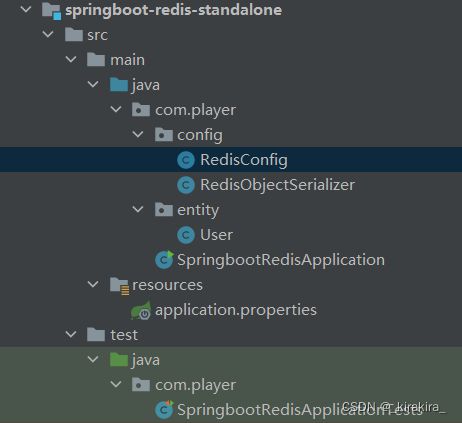从零开始学习SpringBoot——06.使用redis
文章目录
-
- 1.文件组织结构
- 2.redis的连接命令
- 3.可能会出现的报错
- 4.建立Maven项目,写pom文件
- 5.添加 redis 的配置文件
- 6.redis的配置类
- 7.对象的序列化接口
- 8.测试类
- 9.运行结果
1.文件组织结构
2.redis的连接命令
-
redis后台服务器的开启命令:./redis-server redis.conf (在redis-server redis.conf安装目录下运行)
-
redis后台服务器的关闭命令:./redis-cli shutdown (在redis-cli安装目录下运行)
-
redis指定ip和密码连接: ./redis-cli -h 192.168.154.128 -p 6379 -a 123456
3.可能会出现的报错
报错:redis.clients.jedis.exceptions.JedisConnectionException: Failed connecting to host ********
4.建立Maven项目,写pom文件
<project xmlns="http://maven.apache.org/POM/4.0.0" xmlns:xsi="http://www.w3.org/2001/XMLSchema-instance"
xsi:schemaLocation="http://maven.apache.org/POM/4.0.0 http://maven.apache.org/xsd/maven-4.0.0.xsd">
<modelVersion>4.0.0modelVersion>
<groupId>com.playergroupId>
<artifactId>springboot-redis-standaloneartifactId>
<version>0.0.1-SNAPSHOTversion>
<packaging>jarpackaging>
<name>springboot-redis-standalonename>
<description>Demo project for Spring Bootdescription>
<parent>
<groupId>org.springframework.bootgroupId>
<artifactId>spring-boot-starter-parentartifactId>
<version>2.4.6version>
<relativePath/>
parent>
<properties>
<project.build.sourceEncoding>UTF-8project.build.sourceEncoding>
<project.reporting.outputEncoding>UTF-8project.reporting.outputEncoding>
<java.version>11java.version>
properties>
<dependencies>
<dependency>
<groupId>org.springframework.bootgroupId>
<artifactId>spring-boot-starter-data-redisartifactId>
dependency>
<dependency>
<groupId>org.springframework.bootgroupId>
<artifactId>spring-boot-starter-testartifactId>
<scope>testscope>
dependency>
<dependency>
<groupId>redis.clientsgroupId>
<artifactId>jedisartifactId>
dependency>
<dependency>
<groupId>junitgroupId>
<artifactId>junitartifactId>
dependency>
dependencies>
<build>
<plugins>
<plugin>
<groupId>org.springframework.bootgroupId>
<artifactId>spring-boot-maven-pluginartifactId>
plugin>
plugins>
build>
project>
5.添加 redis 的配置文件
# Redis数据库索引(默认为0)
spring.redis.database=0
# Redis服务器地址
spring.redis.host=localhost
# Redis服务器连接端口
spring.redis.port=6379
# Redis服务器连接密码(默认为空)
spring.redis.password=
# 连接池最大连接数(使用负值表示没有限制)
spring.redis.pool.max-active=8
# 连接池最大阻塞等待时间(使用负值表示没有限制)
spring.redis.pool.max-wait=-1
# 连接池中的最大空闲连接
spring.redis.pool.max-idle=8
# 连接池中的最小空闲连接
spring.redis.pool.min-idle=0
# 连接超时时间(毫秒)
spring.redis.timeout=0
6.redis的配置类
package com.player.config;
import org.springframework.beans.factory.annotation.Value;
import org.springframework.context.annotation.Bean;
import org.springframework.context.annotation.Configuration;
import org.springframework.data.redis.connection.RedisConnectionFactory;
import org.springframework.data.redis.connection.jedis.JedisConnectionFactory;
import org.springframework.data.redis.core.RedisTemplate;
import org.springframework.data.redis.serializer.*;
import redis.clients.jedis.JedisPoolConfig;
@Configuration
public class RedisConfig {
@Value("${spring.redis.database}")
private int database;
@Value("${spring.redis.host}")
private String host;
@Value("${spring.redis.port}")
private int port;
@Value("${spring.redis.timeout}")
private int timeout;
@Value("${spring.redis.pool.max-idle}")
private int maxidle;
@Value("${spring.redis.pool.min-idle}")
private int minidle;
@Value("${spring.redis.pool.max-active}")
private int maxActive;
@Value("${spring.redis.pool.max-wait}")
private long maxWait;
@Value("${spring.redis.password}")
private String password;
@Bean
JedisConnectionFactory jedisConnectionFactory() {
JedisPoolConfig config = new JedisPoolConfig();
// 最大空闲连接数, 默认8个
config.setMaxIdle(maxidle);
// 最小空闲连接数, 默认0
config.setMinIdle(minidle);
// 最大连接数, 默认8个
config.setMaxTotal(maxActive);
// 获取连接时的最大等待毫秒数(如果设置为阻塞时BlockWhenExhausted),如果超时就抛异常, 小于零:阻塞不确定的时间, 默认-1
config.setMaxWaitMillis(maxWait);
JedisConnectionFactory factory = new JedisConnectionFactory();
factory.setDatabase(database);
factory.setHostName(host);
factory.setPort(port);
factory.setTimeout(timeout);
factory.setPoolConfig(config);
factory.setPassword(password);
return factory;
}
@SuppressWarnings({ "unchecked", "rawtypes" })
@Bean
public RedisTemplate<String, ?> redisTemplate(RedisConnectionFactory factory) {
RedisTemplate<String, ?> template = new RedisTemplate();
template.setConnectionFactory(factory);
template.setKeySerializer(new StringRedisSerializer());
template.setValueSerializer(new RedisObjectSerializer());
return template;
}
}
7.对象的序列化接口
package com.player.config;
import org.springframework.core.convert.converter.Converter;
import org.springframework.core.serializer.support.DeserializingConverter;
import org.springframework.core.serializer.support.SerializingConverter;
import org.springframework.data.redis.serializer.RedisSerializer;
import org.springframework.data.redis.serializer.SerializationException;
public class RedisObjectSerializer implements RedisSerializer<Object> {
private Converter<Object, byte[]> serializer = new SerializingConverter();
private Converter<byte[], Object> deserializer = new DeserializingConverter();
static final byte[] EMPTY_ARRAY = new byte[0];
public Object deserialize(byte[] bytes) {
if (isEmpty(bytes)) {
return null;
}
try {
return deserializer.convert(bytes);
} catch (Exception ex) {
throw new SerializationException("Cannot deserialize", ex);
}
}
public byte[] serialize(Object object) {
if (object == null) {
return EMPTY_ARRAY;
}
try {
return serializer.convert(object);
} catch (Exception ex) {
return EMPTY_ARRAY;
}
}
private boolean isEmpty(byte[] data) {
return (data == null || data.length == 0);
}
}
8.测试类
package com.player;
import java.util.ArrayList;
import java.util.HashMap;
import java.util.List;
import java.util.Map;
import org.junit.Assert;
import org.junit.Test;
import org.junit.runner.RunWith;
import org.springframework.beans.factory.annotation.Autowired;
import org.springframework.boot.test.context.SpringBootTest;
import org.springframework.data.redis.core.RedisTemplate;
import org.springframework.data.redis.core.StringRedisTemplate;
import org.springframework.test.context.junit4.SpringRunner;
import com.player.entity.User;
@RunWith(SpringRunner.class)
@SpringBootTest
public class SpringbootRedisApplicationTests {
@Autowired
private StringRedisTemplate stringRedisTemplate;
@Autowired
private RedisTemplate<String, User> redisTemplate;
@Autowired
private RedisTemplate<String, List<User>> rt;
@Autowired
private RedisTemplate<String, List<Map<String,Object>>> rm;
@Test
public void test() throws Exception {
// 保存字符串
stringRedisTemplate.opsForValue().set("url", "www.baidu.com");
Assert.assertEquals("www.baidu.com", stringRedisTemplate.opsForValue().get("url"));
// 保存对象
User user = new User("C++", 40);
redisTemplate.opsForValue().set(user.getUsername(), user);
user = new User("Java", 30);
redisTemplate.opsForValue().set(user.getUsername(), user);
user = new User("Python", 20);
redisTemplate.opsForValue().set(user.getUsername(), user);
Assert.assertEquals(20, redisTemplate.opsForValue().get("Python").getAge());
Assert.assertEquals(30, redisTemplate.opsForValue().get("Java").getAge());
Assert.assertEquals(40, redisTemplate.opsForValue().get("C++").getAge());
}
@Test
public void test1() throws Exception{
List<User> us = new ArrayList<>();
User u1 = new User("rs1", 21);
User u2 = new User("rs2", 22);
User u3 = new User("rs3", 23);
us.add(u1);
us.add(u2);
us.add(u3);
rt.opsForValue().set("key_ul", us);
System.out.println("放入缓存》。。。。。。。。。。。。。。。。。。。");
System.out.println("=============================");
List<User> redisList = rt.opsForValue().get("key_ul");
System.out.println("redisList="+redisList);
}
@Test
public void test2() throws Exception{
List<Map<String,Object>> ms = new ArrayList<>();
Map<String,Object> map = new HashMap<>();
map.put("name", "rs");
map.put("age", 20);
Map<String,Object> map1 = new HashMap<>();
map1.put("name", "rs1");
map1.put("age", 21);
Map<String,Object> map2 = new HashMap<>();
map2.put("name", "rs2");
map2.put("age", 22);
ms.add(map);
ms.add(map1);
ms.add(map2);
rm.opsForValue().set("key_ml", ms);
System.out.println("放入缓存》。。。。。。。。。。。。。。。。。。。");
System.out.println("=============================");
List<Map<String,Object>> mls = rm.opsForValue().get("key_ml");
System.out.println("mls="+mls);
}
}


